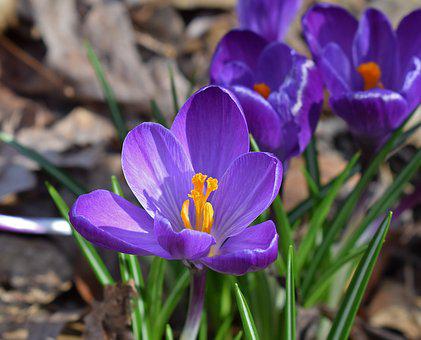Why Do Bulbs Not Produce Flowers?
If your bulbs did not bloom, see these troubleshooting tips to help determine why your bulbs did not produce flowers and assure they come back year after year.
These tips are applicable to hardy spring flowering bulbs. Hardy bulbs are those that are planted in the fall, bloom in the spring and left in the ground year after year.
Examples of hardy bulbs are tulips, daffodils, crocus, hyacinth, grape hyacinth, snowdrops, winter aconite.
Bulbs can adapt to a wide range of growing conditions, but you get the best performance from them when you take extra time to provide the best conditions possible.
Does the location get enough sun?
Most spring bulbs will tolerate filtered sun but they prefer full sun. Filtered sun through leafless deciduous branches is typically acceptable.
If your hardy bulbs partially leaf and do not produce flowers, they may not be getting enough sun.
Were the leaves cut off too soon last year?
It’s tempting to cut the leaves off of bulbs when the last flower has bloomed. But those leaves need to be left in place so they can provide energy to the bulb for next years’ blooms.
Allow leaves to turn yellow or brown before cutting off. An average of 8 weeks after the last flower is a general rule of thumb.
Deadhead regularly to prevent seed pods from forming. Preventing seed pod formation allows the bulb to direct resources to the bulb instead of seed pods. It also keeps the plants tidy.
Low quality bulbs
A good quality bulb is firm to the touch (never squishy).
Quality bulbs have not been sliced or speared nor have large blemishes or scars.
Don’t accept if they have mold growth on them, as that could indicate they were stored improperly.
Inspect bulbs for holes that may be caused by burrowing maggots.
Poor soil
If your soil is clayey and your bulbs are not blooming it’s possible the soil is not draining sufficiently. Removing the bulbs from this condition is critical because if they sit in water they will rot.
Likewise, very sandy soil can be too dry and infertile, not holding enough nutrients and moisture to sustain healthy bulbs. Adding mulch will help the soil maintain moisture.
Bulbs tend to thrive in loamy soil, which holds an adequate supply of nutrients and moisture without getting waterlogged.
If your soil is not naturally loamy, consider adding organic matter to improve quality. Spread a 1-3” layer of compost or other organic matter over the planting area and work into the top 10-12” of soil. For shallower plantings such as crocus, 4-6” should be deep enough.
If you are digging individual holes for each bulb, dig generous holes 2-3” deeper than the planting depth, add organic matter or compost to the base of the hole, set the bulb at proper depth, then add more organic matter with the soil used to fill the hole.
This is the method I use for clay soil that does not drain well. Repeat the process when dividing bulbs, and over time the organic matter will improve the soil quality.
RELATED: Tips for Dividing Perennials in Clay Soil
Bulbs planted at wrong depth
Each bulb variety has an ideal depth they should be planted at. Planting depth gives the bulb the ideal conditions needed to thrive and protects them from temperature changes that could damage them.
Bulbs that have been frozen will be soft and mushy and will not recover.
Check package instructions for the correct depth for your variety or seek manufacturers site.
If you have planted bulbs too shallow and digging them out before winter is not the best option, consider adding additional soil to the surface (to create depth) or a layer of leaves for insulation.
Bulbs planted at wrong time
If bulbs are planted too late in the season, they might not have enough time to develop roots before the ground freezes.
If the blooming season is over and you have eliminated all other possible reasons your bulbs did not bloom, then dig a few bulbs to make sure they are still in-tact.
Bulbs are crowded
If your bulbs bloomed for several years, but now only have sparse leaves and few blooms, it could be time to divide them.
Bulbs reproduce under the ground and get larger as they multiply. Eventually they can grow large enough to crowd each other out of space and resources. For guidance on dividing bulbs see How To Grow Daffodils. Bulbs can be divided in the late summer or early fall after the foliage has died back..
Consider what else has grown around the bulbs over the years – are there roots from nearby plants competing for space, nutrients or moisture? Before replanting, consider what new roots may grow into that location that could crowd the bulbs in the next few years.
For tips on planting bulbs see Flowering Bulbs for the Rock Garden.
Drastic temperature changes
In areas where spring arrives with alternating days of warm and freezing temperatures, bulb flowering might be affected.
Bulbs are very resilient and buds typically handle wide temperature changes from a 70 degree warm blast one day to freezing rains the next day. But some years the timing and harshness can be too drastic and flowering can be sparse if the buds had already formed.
Critters
Mice and squirrels will dig up shallow bulbs and leave them partially eaten on the top of the soil. It’s a frustrating event! If critters are a problem, try covering the area with chicken wire after planting, The wire can be removed in spring after new leaves begin to show.
Rabbits and deer may eat the blooms. Try a repellent to discourage.

Hardy bulbs provide long-term reliable enjoyment with little care. The effort put in to creating the best conditions for your bulbs will pay off year after year.


Comments
Why Do Bulbs Not Produce Flowers? — No Comments
HTML tags allowed in your comment: <a href="" title=""> <abbr title=""> <acronym title=""> <b> <blockquote cite=""> <cite> <code> <del datetime=""> <em> <i> <q cite=""> <s> <strike> <strong>